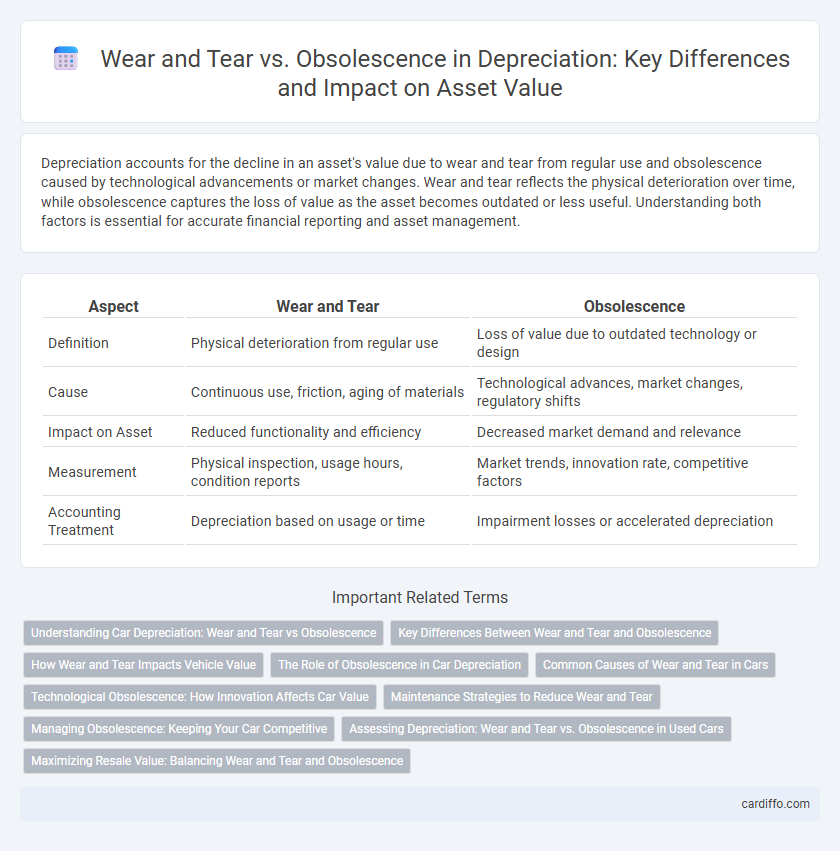Depreciation accounts for the decline in an asset's value due to wear and tear from regular use and obsolescence caused by technological advancements or market changes. Wear and tear reflects the physical deterioration over time, while obsolescence captures the loss of value as the asset becomes outdated or less useful. Understanding both factors is essential for accurate financial reporting and asset management.
Table of Comparison
| Aspect | Wear and Tear | Obsolescence |
|---|---|---|
| Definition | Physical deterioration from regular use | Loss of value due to outdated technology or design |
| Cause | Continuous use, friction, aging of materials | Technological advances, market changes, regulatory shifts |
| Impact on Asset | Reduced functionality and efficiency | Decreased market demand and relevance |
| Measurement | Physical inspection, usage hours, condition reports | Market trends, innovation rate, competitive factors |
| Accounting Treatment | Depreciation based on usage or time | Impairment losses or accelerated depreciation |
Understanding Car Depreciation: Wear and Tear vs Obsolescence
Wear and tear refers to the physical deterioration of a car caused by regular use, such as engine wear, tire degradation, and body damage, which gradually reduces the vehicle's value. Obsolescence occurs when a car becomes outdated due to technological advancements, changes in consumer preferences, or new regulatory standards, leading to a decline in market demand despite its condition. Understanding these two factors is crucial for accurately assessing car depreciation and making informed resale or trade-in decisions.
Key Differences Between Wear and Tear and Obsolescence
Wear and tear refers to the physical deterioration of an asset due to regular usage over time, impacting its operational efficiency and value. Obsolescence occurs when an asset becomes outdated or less useful because of technological advancements, market changes, or new regulations, regardless of its physical condition. The key difference lies in wear and tear being a tangible decline, while obsolescence is a loss of utility or relevance.
How Wear and Tear Impacts Vehicle Value
Wear and tear directly reduces a vehicle's value by causing physical deterioration such as scratches, rust, and worn-out components, which lower its market appeal and resale price. This gradual loss in condition affects the vehicle's operational efficiency and safety, further diminishing buyer interest. Unlike obsolescence, which relates to outdated technology or design, wear and tear reflects tangible damage that requires repair or maintenance to restore value.
The Role of Obsolescence in Car Depreciation
Obsolescence plays a significant role in car depreciation by accelerating value loss as newer models with advanced technology and features enter the market. Unlike wear and tear, which results from physical use and age, obsolescence reduces a car's market desirability regardless of condition. This phenomenon impacts resale value and insurance assessments by factoring in outdated design, fuel inefficiency, and lack of modern safety systems.
Common Causes of Wear and Tear in Cars
Common causes of wear and tear in cars include friction from engine components, tire abrasion, brake pad erosion, and suspension system degradation. Continuous exposure to weather elements like rain, snow, and UV rays accelerates corrosion and material fatigue. Regular driving on rough roads increases strain on the vehicle's chassis, contributing significantly to mechanical deterioration.
Technological Obsolescence: How Innovation Affects Car Value
Technological obsolescence significantly impacts car value by reducing the market demand for models with outdated features or less efficient technology. Innovations such as electric powertrains, advanced driver-assistance systems, and connectivity integration accelerate depreciation by making older vehicles less desirable. This form of obsolescence leads to faster loss of value compared to normal wear and tear, as consumers prioritize cutting-edge performance and sustainability.
Maintenance Strategies to Reduce Wear and Tear
Effective maintenance strategies such as regular lubrication, timely repairs, and preventive inspections significantly reduce wear and tear on assets, extending their useful life and minimizing depreciation expenses. Implementing condition-based maintenance leverages sensor data to identify early signs of deterioration, enhancing asset reliability and operational efficiency. These approaches help businesses optimize maintenance costs while preserving asset value against physical depreciation.
Managing Obsolescence: Keeping Your Car Competitive
Managing obsolescence involves regularly updating your car's technology and features to maintain its market value and competitiveness. Incorporating software updates, aftermarket upgrades, and modern accessories helps counteract the loss in value caused by rapid technological advancements. Proactive maintenance combined with timely enhancements can significantly slow depreciation linked to obsolescence rather than physical wear and tear.
Assessing Depreciation: Wear and Tear vs. Obsolescence in Used Cars
Assessing depreciation in used cars involves distinguishing between wear and tear and obsolescence, two key factors that impact value reduction. Wear and tear reflects physical deterioration from regular use, such as tire wear and engine fatigue, while obsolescence relates to loss of value due to technological advances or model redesigns. Accurate depreciation calculations require evaluating both the car's condition and market trends to determine fair resale price.
Maximizing Resale Value: Balancing Wear and Tear and Obsolescence
Maximizing resale value involves carefully managing both wear and tear and obsolescence to maintain asset condition and market relevance. Regular maintenance minimizes physical deterioration while timely upgrades or replacements address obsolescence caused by technological advancements. Strategic balance between preserving functionality and adopting innovations enhances asset longevity and maximizes return on investment.
Wear and Tear vs Obsolescence Infographic

 cardiffo.com
cardiffo.com